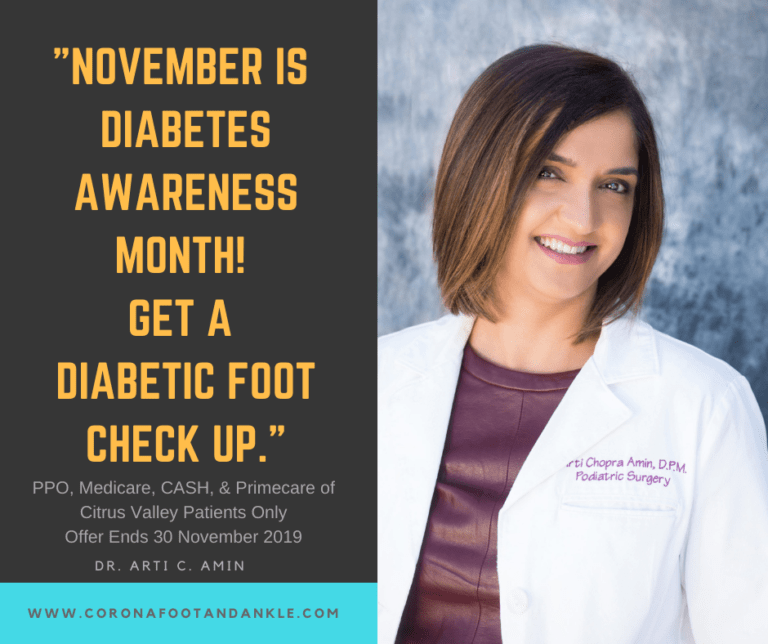
Corona, CA
Are you a diabetic?
November is National Diabetes Month, a time for individuals, health care professionals, organizations, and communities across the country to bring attention to diabetes and its impact on millions of Americans. One-in-ten Americans have diabetes – more than 30 million people – and another 84 million American adults are at high risk of developing type 2 diabetes. Diabetes is one of the leading causes of disability and death in the United States. It can lead to blindness, nerve damage, kidney disease, loss of toes and feet, and other health problems if not controlled. Both type 1 and type 2 diabetes can cause damage to blood vessels and peripheral nerves that can result in problems for legs and feet. Luckily, regular visits to a podiatrist can help reduce the risk of developing risky side-effects from diabetes.
Foot problems are common in people with diabetes. This is because, over time, diabetes can cause nerve damage, diabetic neuropathy, that can cause one to lose sensation in feet. As a result, you may not feel a cut or blister, which would increase the risk of infection. Diabetes can also reduce blood flow to your feet and legs, making it harder for infections to heal, which could lead to gangrene. If gangrene does not respond well to treatment, it can necessitate an amputation of your toe, foot, or part of your leg. Regular visits with a podiatrist can help monitor your feet, as well as help you create a routine for self-monitoring and prevention in between visits.

In addition to diabetic neuropathy, diabetes may also lead to peripheral vascular disease, which is when fatty deposits block blood vessels beyond the brain and heart and primarily blood vessels leading to and from the extremities. Reduced blood flow to your legs and feet can also cause pain, infection, and reduce healing time.
Prevention is critical. Among the steps recommended for all people with diabetes are to examine their feet daily for any signs of redness, blisters, cuts or sores; to wear well-fitting shoes and protect their feet from injury; and to remove their shoes and socks at each diabetes-related checkup so feet can be examined.
Dr. Amin is an expert at working with diabetes patients. At Corona Foot and Ankle Group, Dr. Amin can conduct examinations and should a wound present, she can offer an individualized treatment plan to address the wound immediately to avoid sometimes life-threatening complications. At Corona Foot and Ankle Group we believe in the significance of patient education. We want all of our patients to understand the importance of a comprehensive, daily routine to avoid a wound going unnoticed and untreated.
Treatment depends on the type of problem. For example, an infection may call for antibiotics whereas corns may require wearing corrective shoes. Most diabetes foot-related problems can be prevented by taking careful steps to observe and care for your feet, keeping blood sugar under control, and following the day-to-day recommendations of your podiatrist.
If you have a wound or if you have diabetes and want to learn about specific preventative measures you can take to avoid complicating wound injuries or treatment options for existing conditions, make an appointment now with the knowledgeable staff at Corona Foot and Ankle. Dr. Amin is trained to diagnose and treat both diabetic neuropathy and peripheral vascular disease. She is very knowledgeable about diabetes and specifically the effects in can have on your legs, feet, and toes. Don’t wait until symptoms worsen; make an appointment now.
Have any questions about treatment? Feel free to make an appointment, Our team will reach you soon!
Contact Us